In the March 2021 issue of Aviation Safety magazine, I discussed the need to restructure the way we teach flying, to focus ab initio training on developing habits that don’t have to be unlearned as one progresses through flight training and into advanced ratings and operations. The classic example is developing in students the habit of using airspeed as a measure of how close the airplane is to stalling. As I discussed in that article, the problem with developing this habit is that angle of attack (AOA) is what determines how close we are to stalling, and that airspeed is only one (imperfect) way to measure it.
Habits are learned things that we do when certain cues or trigger events are recognized by our senses and sent to the brain. Almost everything we do routinely eventually becomes habit. The problem is our brain can’t quickly tell us the difference between a good habit and a bad one. Flying an airplane is no different. If you are landing on Runway 36 and winds are from 090 at 10 knots, your brain tells you that you have a crosswind from the right. The way you compensate for the crosswind, smoothly touch down and maintain directional control as you roll out is learned behavior, a habit formed after training and practice.
Habits In Three Dimensions
We humans have a lot of habits useful in a two-dimensional world of normal life, but which are not so useful when flying an airplane. Some of them, in fact, are outright dangerous. When driving, for example, we add power to go faster. To slow down, we apply brakes. Both functions are enabled by tire friction on the road created by gravity. When we begin learning to fly, we bring all those cues and habits with us. So, when that to-be pilot does his first takeoff, the act of pushing the throttle in just like when we want to go faster with a car becomes a relationship-triggering cue.
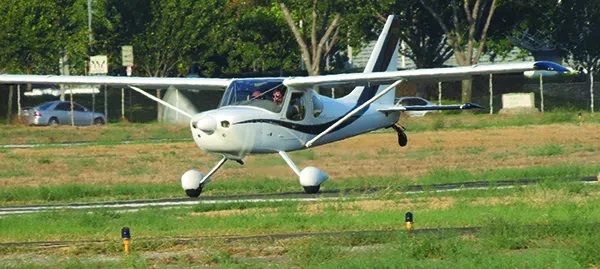
Initially, it is a valid cue because at the time throttle is added for takeoff, the airplane is still in the two-dimensional world. But the moment the airplane becomes airborne, it (and the pilot/passengers) is/are no longer dominated by the rules of a two-dimensional world. It’s now in a three-dimensional world where it can and does create its own form of gravity. And, as might be expected, many, if not most, of the “rules” governing a two-dimensional world are transformed. Accordingly, many of the “habit rules” also change.
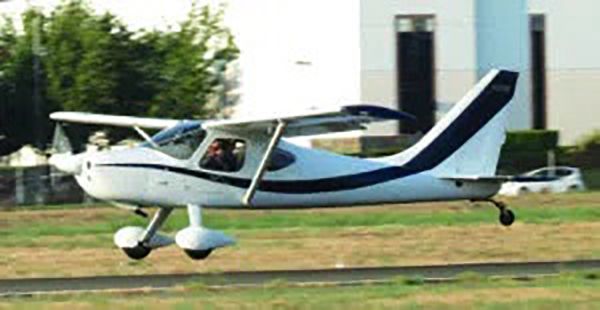
The new three-dimensional world now controls the force of gravity, becoming at best, a source shared with the airplane’s self-created gravity derived from lift in the three-dimensional element of an airmass. In this three-dimensional environment, the airplane climbs (goes away from the earth’s surface) as a function of power in excess of the amount needed to balance lift with gravity. Adding power does not necessarily make the plane go faster as it does when adding it to a car. In the three-dimensional environment, the airplane goes faster or slower as a function of the wing’s angle of attack.
In wings-level cruise flight, pitching the airplane’s nose up or down changes the angle of attack—using the air surrounding the airfoil to either add speed or to achieve a slower airspeed. In the three-dimensional world the airplane inhabits, speed is not necessarily a function of adding or removing power.
Transferred Habits
Many pilots learn to fly by modifying the cues they first learned in driving an automobile. In hindsight, I most assuredly did, and in the intervening years little has changed with respect to understanding how driving habits are transformed to flying habits. Partially in response to learning to operate ground-based personal transportation—an automobile— airspeed is often the primary metric to determine aircraft control among ab initio students. In one sense, this is okay in that it allows pilots to hone driving habits to meet aircraft flight needs. But it fails to teach pilots how to deal with the true aerodynamic elements of flight in critical or surprising situations. Support for this habit is found in FAA-approved pilot handbooks and operating manuals, where some critical aspects of flying all reference airspeeds, not pitch-and-power criteria.
While pilots often intellectually understand pitch-and-power flight paradigms and can deal with the concepts cognitively when taking their written and flight exams, core flying habits often remain cued by the driving habits learned in the two-dimensional world. Little or no effort in flight training addresses habit-building aspects that should be used for safer flight.
As a pilot, how can you know to what extent your flying techniques are controlled “modified driving” habits taken from our two-dimensional world or “pitch and power” habits needed for safe aerodynamic flight in the three-dimensional world? Let’s explore how habits can be transferred from the two-dimensional world to the one in which we fly.
Chasing Airspeed
Chasing airspeed is a common carryover habit where the pilot shoves the nose of the airplane to the pitch attitude that is anticipated and then uses changing combinations of pitch and power to achieve the airspeed desired or expected. This scenario can be seen following a climb to cruise altitude, a request by ATC to maintain a given airspeed and very often during landing approaches. This technique is reinforced by the FAA’s focus on airspeeds in manuals, rules, regulations, training material and doctrine.
Airspeeds are a function of pitch and power settings. Pilots should know and fly to pitch and power settings, and use airspeed as a verification once the airplane is stabilized in the correct pitch and power setting for the desired phase of flight.
Driving The Airplane
That our early aviation habits often are formed in automobiles on the ground is generally most obvious during landings. Pilots identify the intended landing target and then attempt to “drive” the airplane to it by using the yoke as a steering wheel to aim the airplane at the target. Configuration changes result in pitch and power excursions as the pilot attempts to keep the airplane pointed at the target using pitch and roll alone. Even the most sophisticated of these approaches are unstable and landings are inconsistent.
Pilots flying pitch-and-power landings reduce power while maintaining a stable pitch attitude with the aiming point lying just above the nose. Pitch is used to control airspeed only and power is to control the sink rate. Flaps are used to maintain a slower airspeed at roughly the same attitude during the initial approach phases, and added when the target is assured to slow the airplane to minimum flyable airspeed at touchdown.
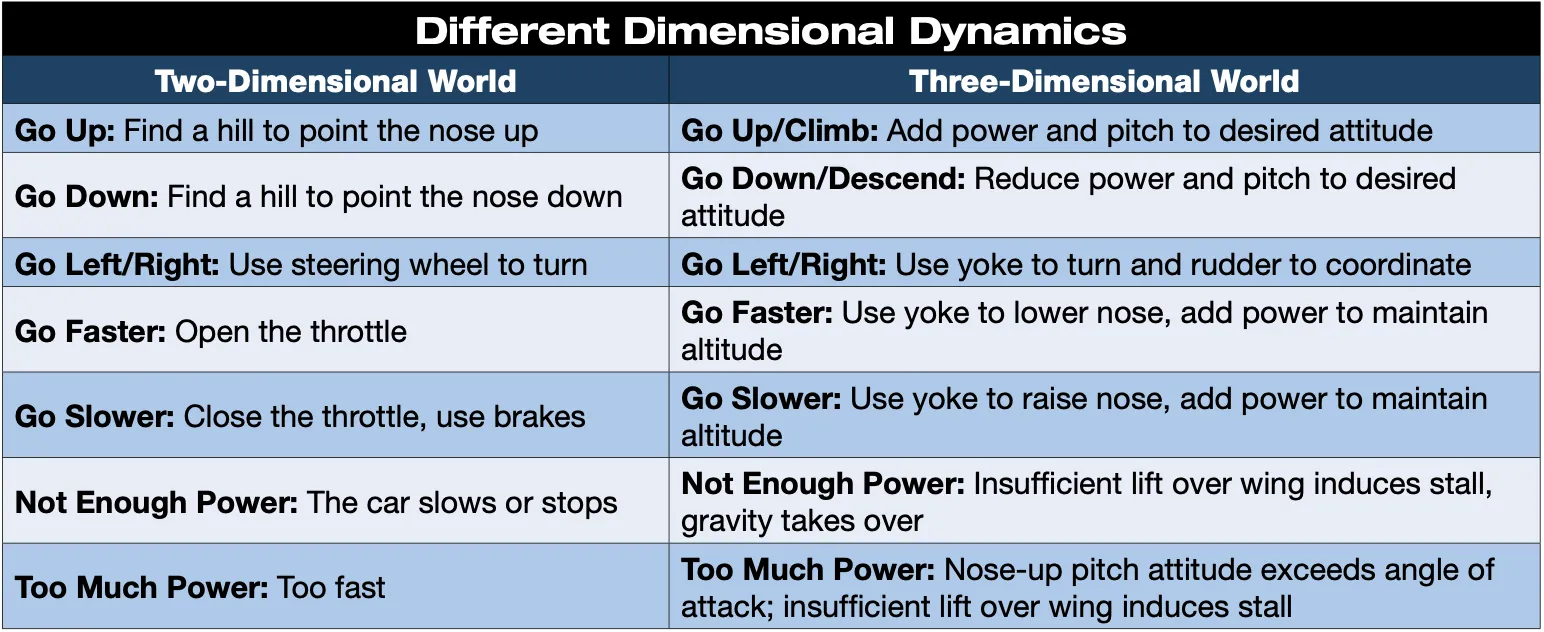
Crosswind Landings
Crosswind landings are often a real problem for a pilot with two-dimensional flying habits. The pilot points the airplane at the target as if driving it to the runway, as described previously, but the crosswind moves the airplane away from the target. So, the more sophisticated two-dimensional pilot reacts to the point that a crab approach seems to be working. This varies, depending on pilot experience. Perhaps like you, I’ve experienced approaches flown by other pilots that were a constant series of pitch and bank attitude changes.
This oscillating directional control continues over the runway and, with luck, the pilot forces the plane onto the runway during the oscillations. The landing is invariably fast, hard and cross-loads the landing gear. Experienced two-dimensional pilots will sometimes try to add some cross-controlled rudder/aileron control, but it rarely is sufficient to control the drift.
Correctly flown crosswind landings should be in a stable approach configuration as described above, using pitch and power to control airspeed and descent rate. A crab can be used to offset the crosswind, with the plane kept at an angle into the wind throughout the approach so that its path to the runway is aligned with the extended runway centerline. A cross-controlled, wing-down-into-the-wind slip can be used to keep the plane’s nose aligned with the target and extended centerline. Some experienced pilots and those confronting stiff crosswinds find that a combination of these two crosswind techniques—the crab and the slip—often work well.
If a crab is used in the approach, it should transform into a wing-down-into-the-wind slip during the roundout and flare so that the upwind wheel touches down first, at minimal flying speed. If a slip has been used throughout the approach, it should be slightly increased in the roundout and flare to ensure minimum flyable airspeed at touchdown.
Stalls
Stalls are a classic problem for pilots who have not overcome their two-dimensional habits. As the wings lose lift, the airplane becomes almost totally subject to gravity. The habit cue seen by the pilot is one of falling. The initial reaction is to pull nose-up on the pitch control. But, in many cases, that initial habit cue has been supplemented by a “fear habit” drilled into the pilot by his/her flight instructor—to shove the nose aggressively down to regain lift. Both habits are two-dimensional. In general aviation aircraft, the correct pitch-and-power response should be to ease the nose down to the point that airflow over the wing generates lift, steering with one’s feet and using gravity to establish a pitch attitude that generates lift.
Putting It All Together
What we learn and why before we begin flight training impacts how well we progress and can convert older, learned habits that may not help us in the cockpit. Realizing the root causes of those bad habits is the first step toward changing them and becoming a better, more skilled pilot.
Habits = A Delayed Reaction?
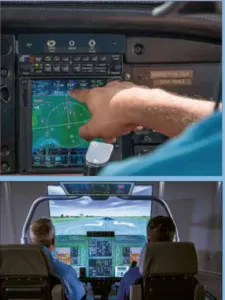
As this article’s main text discusses, there are fundamental differences between the dynamics of moving in the two-dimensional world and the aerodynamics of the three-dimensional world. Over time, with repetitive training, two-dimensional flying habits come to have the “look and feel” of three-dimensional habits even though the fundamental core of the habit is different.
It’s critical to know that habits are things we do automatically, triggered by visual or situational cues. They happen before we even think about them and, often, without thinking about them at all. In flight, a two-dimensional habit can often trigger an incorrect result, which then is corrected as soon as the cognitive mind recognizes the error. But cognitive recognition can take time, a second or longer. If there is time to recognize the error, safe flight continues.
However, a two- or three-second delay for cognitive thinking to recognize that an incorrect habit response has been triggered can be risky when a “surprise” or “unexpected” events triggers the wrong habit cue. Those incorrect habit responses have induced a close-to-the-ground stall from which there is insufficient time to recognize and correct the mistake.
The author’s study of loss-of-control inflight (LOC-I) incidents seems to indicate that incorrect response to aerodynamic cues induced recall of a two-dimensional habit in lieu of recall of a three-dimensional habit. And as is clear from the statistics, LOC-I remains the number one cause of fatal accidents.
Habits Can Be Changed, Replaced
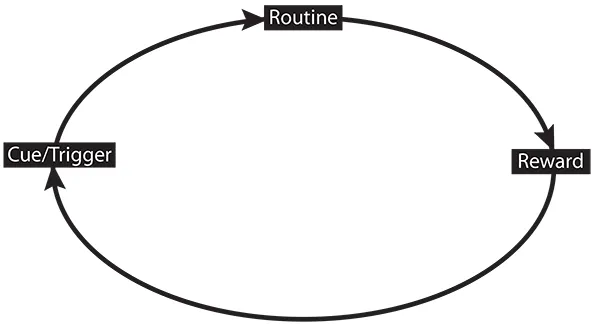
Identify the Cue
Stress often is a trigger for a habitual response. As you become more familiar with the operation, it becomes less stressful and easier to identify.
Avoid the Cue OR Find a New Routine
Make it easier on yourself to break bad habits by avoiding the things that cause them. The earlier the bad habit is identified, the easier it is to avoid and/or replace it.
Expect New Result
When you change your behavior/habit, expect a different result. Embrace the famous quote attributed to Albert Einstein—that insanity is doing the same thing over and over again and expecting different results—by changing your responses to the cue.
Cognitively repeat until New Routine becomes Habit
Habits are encoded into the our brains and the only way to change them is to to identify the habit’s trigger, take a different action and observe the new result.
Obtain Clear Result that is identifiably better
It’s hard to change a habit when the result of the new behavior isn’t clear. Making better landings can be its own reward, for example.
This article originally appeared in Aviation Safety magazine.
For more great content like this, subscribe to Aviation Safety!



































Mr. Eastman, I would like to talk with you. You are on the right track but I see some things I would certainly change in your article such as:
1. Airspeed *IS* important. It tells you how much lift the wing CAN produce (‘G’ you can pull for maneuvering) and how much kinetic energy the aircraft has available for maneuvering. You are correct in that it tells you very little about how far you are from stall. AoA tells you that.
2. The elevator does not control pitch. The elevator controls AoA. It is the change in AoA which provides immediate change in lift, which causes the aircraft to accelerate in the direction of the summed vectors, primarily lift in this case. We perceive this as a change in pitch because that appears to be the instantaneously changed variable. Once the aircraft has its AoA established by the elevator (trim) the dynamically stable aircraft will then seek the airspeed which results in equilibrium of all the forces, i.e. it achieves steady-state unaccelerated flight. If the power is excess to that required for level flight, the aircraft will now be climbing at a steady rate. If the power is insufficient for level flight, the aircraft will be descending at a steady rate. (More on this later.)
Really understanding how the airplane flies requires an understanding what we can change, i.e., AoA and power, and how they relate to what we want the airplane to do. Also, we need to be aware of our energy state, which tells us what we CAN do. Insufficient energy means we are extremely limited, perhaps even to the point of not being able to keep the flight path of the airplane from intersecting the earth. (This is otherwise knows as a “crash”.)
We have two forms of energy: potential and kinetic. Potential energy is energy of altitude. The higher we are above the ground, the more available energy we have from gravity. Kinetic energy is energy of speed. It is what we need to actually maneuver the airplane. The more kinetic energy we have, the greater and more rapid change in direction is available to us. We can trade one for the other as the need arises. We create energy with the engine and we lose energy with drag. The end result is, if you aren’t adding energy to the system rapidly enough (we don’t have enough power), the energy state is decreasing. Our only choice then is to trade potential energy (altitude) to sustain our kinetic energy (speed) so we can continue to maneuver. Attempts to violate this will result in our airspeed being low enough that we can no longer generate the lift needed for level flight and we allow the wing to stall.
Wow, that was a WHOLE bunch of physics there. I am sure that Sir Isaac Newton would be proud of me.
So how do I teach this? The easiest way is by forcing the new pilot to maneuver in the vertical, being aware of energy state (speed and altitude) and how that is constantly changing. The student quickly learns that kinetic energy (speed) provides much more maneuvering margin. Not enough kinetic energy? We must add energy with the engine OR change our altitude to convert potential energy into kinetic energy (dive). Nothing does this better than an introduction to aerobatics. The military understands this and requires a student to complete both a module on aerobatics and a module on upset prevention and recovery training BEFORE allowing the student to solo.
One last thing. You referenced Albert Einstein so I will do so as well. One of the quotes attributed to him is, “Things should be made as simple as possible, but no simpler.” That means we can only dumb this down so much before it becomes meaningless. We need our students understand what the lift formula tells us about the wing’s behavior, and what basic Newtonian physics tells us about the manipulation and management of the aircraft’s energy state. We need to then create an environment in which the student can learn this intrinsically so that she has manages energy and flight path without applying conscious thought, i.e. achieves the state of unconscious competence, sometimes called “muscle memory”. And as you stated, this involves unlearning a bunch of things that we “know” from living in a flat, 2-dimensional world. And as CFIs, we learned that unlearning a behavior and then replacing it with a new behavior requires a LOT more time and effort than just learning a behavior in the first place. That means we need to start this process early on, maybe with the very first lesson. “What is learned first is learned best,” suggests that we need to put our best CFIs with our newest students to ensure that they really learn how airplanes fly.
Something tells me that we need a better textbook for all of this.
With all due respects to both Mr. Eastman and Brian L, sometimes simpler is a whole lot better. This joke is relevant: pull back, the trees grow smaller; pull back more, the trees get bigger again. I’m reminded of a time eons ago when I didn’t know how to operate a King audio panel. Instead of telling me which way to move the switches, the instructor gave me a dissertation on the innards of the box, and when he was finished, I still didn’t know which way to move the switches.
Knowing about angle of attack is important, but until all airplanes are equipped with AOA indicators, airspeed is still pretty relevant. Granted that transitioning from the habit of checking airspeed to checking the AOA indicator takes time (I’ve had an AOA indicator in my airplane for many years, and yet I still tend to check the ASI first), and many car-related habits need to be unlearned in the process of becoming a pilot, the fact is that thousands and thousands of pilots have learned to be really good pilots anyway. Getting into the time worn argument about which controls speed, pitch vs. power, in my opinion, isn’t helpful, nor is whether the elevators control pitch or angle of attack. Pretty soon, all that becomes is a mere exercise in pedantry.
A Cessna 185 with a baggage pod for example can be several different airplanes requiring several different airspeeds depending on weight in professional short and unimproved airstrip operations. I have found valuable a simple homemade wing mounted rotating AOA double vane and pointer on a quarter round scale with two very visible index marks at the positions on the scale where Vso and Vx occur. For heads up viewing, a low profile mirror in the pilot’s forward line of sight above the instrument panel pointing at the AOA vane and scale works well while keying on the touch down point.
To calibrate this AOA, overlay the scale with masking tape on which you write numbers from 1 to 10. Then fly a series of stalls at Vso noting at which number the pointer is pointing most consistently during the stall. You may want to hold it in a straight ahead stall for half a minute or so to confirm your finding. That position will then be your Vso stall AOA hash mark on the scale. Then carefully fly at the manufacturer’s published Vx for weight and note the number at which the pointer is pointing. That position will then be your AOA hash mark for best angle of climb which is also a good safe slow approach to a short field. You can now very accurately fly at multiple weights unimpeded by airspeed calculations into and out of short fields with a totally clogged up airspeed indicator.
I’d post photos of my AOA here if I could. This AOA for obvious reasons is not useful in icing conditions. This was the idea of a friend of mine, and someone smarter and more enterprising than I am can patent this device someday.
I would easily agree with Cary that simpler is better. To me, the best way to make things simple and result in the best possible understanding and skill is to make sure that what is taught is technically correct. For example I would have a problem with “Airspeeds are a function of pitch and power settings. Pilots should know and fly to pitch and power settings”. That seems to be leaving out the real world. That sentence implies that reaching cruise altitude, setting the airplane to a predetermined pitch and power will always result in a previously expected airspeed. No, sometimes not even close. Downdrafts can cost a lot of cruise speed so I don’t think airspeed verifies anything and trying to achieve an airspeed that is temporarily unattainable means the pilot would be putting pitch and power in the wrong place. It indicates a misunderstanding of the sequence in which controls are set and all of the factors that then affect performance. For cruise flight, there’s only one thing that is certain – the rpm you are going to set – i.e. the power you decided to use and wrote down on your navlog, which was then going to let you estimate all of that other stuff – fuel burn, range, ete, eta, etc. Pitch keeps the altitude but it has to be adjusted to ‘whatever is necessary’ and it’s always changing (very small amounts usually but some days plenty). Speed is then ‘observed’ and is the result of the drag being produced after rpm is set on the tach per the plan on the navlog and pitch is maintaining altitude; speed is not a value you can always manipulate.
I don’t want to get into a book, but can’t leave without mentioning pitch and power on approaches, because I can see with you saying “Pitch is used to control airspeed only and power is to control the sink rate” that again this is not including reality and will leave people unprepared. In gusting conditions, the pilot who pitches to airspeed is in trouble because the efforts to adjust pitch to maintain speed will destabilize the line of flight. The fact is that what you call ‘driving’ the airplane to the aiming point is the correct technique – it works in all conditions and far more accurately. And maintaining a precise airspeed on the airspeed indicator is actually a misrepresented goal because we know everyday there are airplanes making safe approaches in gusting conditions and their airspeed is bouncing 10 or even 20kts. Pitching to the aiming point also allows pilots to progress when they fly autopilot equipped airplanes because the autopilot will manipulate the elevator the same way that pilot was using it to ‘drive’ to the aiming point. With your method of pitching to airspeed, you will have to learn to manage speed with a new control (the throttle) because the autopilot is now in control of the elevator to maintain glideslope. You also are saying flaps are lowered to achieve the correct airspeed on the approach. What about airplanes that don’t have flaps – if I followed your technique I would have been unable to fly a Citabria. The objective on approaches is to use the elevator to establish a line of flight to the aiming point which will be at a descent angle within the performance capability of the airplane and will safely avoid obstacles. I learned to do that as a student pilot in an American Grumman and I never had to change one thing as I later flew many other singles and twins, turbine models, and one jet. That is the best example of simplicity – learning a universal skill which will work in all aircraft and in all non-emergency conditions. Your techniques only work in certain conditions so two things are bound to happen – inconsistent results and the pilot will to have to unlearn and relearn some critical skills, something that should never happen.